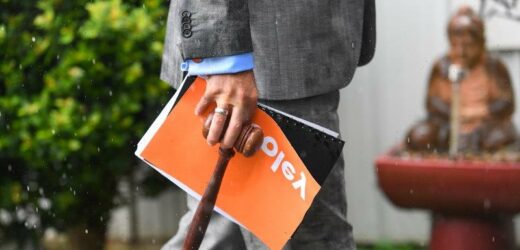A quarter of a million home buyers in NSW and another 350,000 in Victoria in some of the country’s key swing electorates will face their first ever interest rate rise if the Reserve Bank, as expected, starts tightening monetary policy this week.
As both major parties claimed their policies would help people get into the property market, economists and financial markets expect the sharpest lift in official interest rates since the country emerged from the global financial crisis.
A quarter of a million NSW residents and 348,000 in Victoria will soon face their first interest rate rise.Credit:Peter Rae
Financial markets have fully priced in the cash rate being pushed to 0.25 per cent at Tuesday’s RBA board meeting, with a 0.4 percentage point increase a one-in-three chance. Any increase would be the first since November 2010 when the Reserve took the cash rate to 4.75 per cent.
Since then, almost 1.2 million first time buyers have entered the property market of which more than half have been in Victoria and NSW. Many have bought into key marginal swing seats such as La Trobe and McEwen in Melbourne, Lindsay in Sydney and Pearce in Perth.
Not only have marginal seats been filled with home buyers who have never faced an interest rate rise on their mortgage, the size of their loans have swelled.
The average first mortgage is $600,000 in NSW after being $339,000 in November 2010. In Victoria, the average mortgage for a first time buyer has climbed to $490,000 from $309,000.
AMP Capital chief economist Shane Oliver said the Reserve Bank had to act this week, in part because it made no sense to leave rates unchanged given unemployment is at 4 per cent and the inflation rate is at 5.1 per cent.
“The experience from the late 1960s and 1970s tells us the longer high inflation persists the more inflation expectations will rise making it even harder to get inflation back down again without engineering a recession,” he said.
First home buyer numbers surged through 2020 as mortgage interest rates fell to record lows. There was also a sharp drop in the number of investors in the property market with the value of investor loans in Queensland alone at their lowest level this century.
Since peaking in January 2021, first home buyer activity has collapsed by almost 40 per cent. In NSW, the number of first time buyers taking out mortgages has fallen by 55 per cent, down to where they were in October 2019 while they have fallen a third in Victoria.
The Coalition introduced a first home buyers deposit scheme under which the government guarantees up to 15 per cent of a mortgage for buyers with a deposit as low as 5 per cent. Single parents can have a deposit as low as 2 per cent.
The Coalition announced early in the election campaign it would increase the caps on its scheme to $900,000 in Sydney and $800,000 in Melbourne. The caps for regional parts of NSW and Victoria were also increased.
Labor on Sunday revealed its Help to Buy program, a shared equity scheme under which the government would contribute up to 40 per cent of the purchase price of a new home and up to 30 per cent of the purchase price for an existing home.
Finance Minister Simon Birmingham said the Coalition’s scheme was a better way to help people into the property market without direct government intervention.
“You don’t have Mr Albanese at the kitchen table with you owning part of your home with you,” he said.
Anthony Albanese said at Labor’s campaign launch said his $329 million proposal, planned to start from January 1, would help those kept out of the property market.
“For too long, Australians who have worked hard have been locked out of the housing market by flat wages and rising prices, unable to even get a foot in the door let alone their own roof over their heads. We can do better than this,” he said.
To cover the cost of the program, Labor said it would double foreign investment screening fees and penalties in a move it argued would raise $445 million.
Labor’s policy is very similar to a proposal from independent think tank the Grattan Institute which earlier this year put forward a shared equity scheme. It recommended lower income thresholds and a smaller number of potential loans than Labor’s proposal.
Grattan’s economic policy director Brendan Coates said the scheme would be particularly useful for people in their 40s or 50s who had been unable to get into the property market.
This group was most likely to end up in poverty in their retirement years.
Coates said shared equity, on top of the existing deposit insurance scheme, would marginally improve a property market that also require further changes.
“It’s not a panacea but this scheme has a role to play. And there are other areas that still need work, like policies to boost supply and changes to the tax system,” he said.
Barrenjoey chief economist Jo Masters said like all subsidy schemes, Labor’s proposal would probably put upward pressure on prices.
But for those on the scheme, the repayments would be substantially lower.
“These people are going to have much smaller mortgages so for them that’s a big positive, and for the government there’s actually scope for them to ultimately make money,” she said.
Cut through the noise of the federal election campaign with news, views and expert analysis from Jacqueline Maley. Sign up to our Australia Votes 2022 newsletter here.
Most Viewed in Politics
From our partners
Source: Read Full Article



